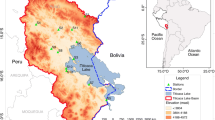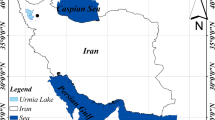Abstract
Different processes of lake surface water temperature (Tsw) are considered in this work. The Tsw estimation is based on the energy budget method and Artificial Neural Networks (ANNs models).These processes were applied to Vegoritis Lake in northern Greece. For the analysis, daily meteorological data, lake characteristics, as well as simulation results from an integrated heat transfer model were used for two complete years. The simulation results from the heat transfer model are considered as the reference and more accurate procedure to estimate Tsw. These results are used to compare the performance of the other processes. The examined processes include:(a) models of heat storage changes in relation to net radiation values Qt(Rn); (b) net radiation estimation using different approaches, such as the process of Slob’s equation with adjusted coefficients to lake data; and (c) ANN models with various architectures and input variables. The results show that the surface water energy budget model accurately describes the temperature (r2 = 0.916, RMSE = 2.422 °C). The ANN(5,6,1) model in which Tsw(i-1) is incorporated in the input variables was considered the best performing compared to all other ANN structures (r2 = 0.995, RMSE = 0.490 °C). Using different approaches for simulating net radiation (Rn) and Qt(Rn) in the equation of surface water temperature estimation provides results with lower accuracy.







Similar content being viewed by others
Availability of Data and Materials
The datasets generated during and/or analysed during the current study are available from the corresponding author on reasonable request.
References
Adrian R, O’Reilly CM, Zagarese H, Baines SB, Hessen DO, Keller W, Livingstone DM, Sommaruga R, Straile D, Donk EV, Weyhenmeyer GA, Winder M (2009) Lakes as sentinels of climate change. Limnol Oceanogr 54:2283–2297
Allen RG, PereiraL S, Raes D, Smith M (1998) Crop evapotranspiration - Guidelines for computing crop water requirements. FAO Irrigation and drainage paper 56.
Antonopoulos VZ (2006) Water movement and heat transfer simulations in a soil under ryegrass. Biosyst Eng 95(1):127–138
Antonopoulos VZ, Gianniou SK (2003) Simulation of water temperature and dissolved oxygen distribution in Lake Vegoritis. Greece Ecol Model 160:39–53
Antonopoulos VZ, Antonopoulos AV (2017) Daily reference evapotranspiration estimates by artificial neural networks technique and empirical equations using limited input climate variables. Comput Electron Agric 132:86–96
Antonopoulos VZ, Gianniou SK, Antonopoulos AV (2016) Artificial neural networks and empirical equations to estimate daily evaporation: application to lake Vegoritis. Greece Hydrol Sci J 61:2590–2599
Antonopoulos VZ, Papamichail DM, Aschonitis VG, Antonopoulos AV (2019) Solar radiation estimation methods using ANN and empirical models. Comput Electron Agric 160:160–167
Arhonditsis GB, Brett MT, DeGasperi CL, Schindler DE (2004) Effects of climatic variability on the thermal properties of Lake Washington. Limnol Oceanogr 49:256–270
Aschonitis VG, Antonopoulos VZ (2008) Evaluation of the water balance and the soil and ponding water temperature in paddy-rice fields with the modified GLEAMS model. Inter.Conf. on Agri.Engine., AGENG2008, Grete, Greece, 23–25 June 2008, 8p.
Aschonitis VG, Papamichail D, Demertzi K, Colombani N, Mastrocicco M, Ghirardini A, Castaldelli G, Fano E-A (2017) High-resolution global grids of revised Priestley-Taylor and Hargreaves-Samani coefficients for assessing ASCE-standardized reference crop evapotranspiration and solar radiation. Earth Syst Sci Data 9:615–638. https://doi.org/10.5194/essd-9-615-2017
Bowie GL, Mills WB, Porcella DB, Pagenkopf JR, Rupp GL, Johnson KM, Chan PW, Gherini SA, Chamberlin CE (1985) Rates, constants and kinetic formulations in surface water quality modeling. U.S. Environmental Protection Agency, ORD, Athens GA, ERL, EPA/600/3–85/040.
Burba GG, Verma SB, Kim J (1999a) Surface energy fluxes of Phragmites australis in a prairie wetland. Agric Forest Meteorol 94:31–51
Burba GG, Verma SB, Kim J (1999b) A comparative study of surface energy fluxes of three communities (Phragmites australis, Scirpus acutus, and open water) in a prairie wetland ecosystem. Wetlands 19:451–457. https://doi.org/10.1007/BF03161776
Chapra SC (1997) Surface water-quality modeling. McGraw-Hill Book Company, New York, p 844
Choudhury BJ, Idso SB, Reginato RJ (1987) Analysis of an empirical-model for soil heat-flux under a growing wheat crop for estimating evaporation by an infrared-temperature based energy-balance equation. Agric Forest Meteor 39:283–297
Clothier BE, Clawson KL, Pinter PJ, Moran MS, Reginato RJ, Jackson RD (1986) Estimation of soil heat-flux from net-radiation during the growth of alfalfa. Agric Forest Meteor 37:319–329
Confalonieri R, Mariani L, Bocchi S (2005) Analysis and modelling of water and near water temperatures inflooded rice (Oryza sativa L.). Ecol Mod 183:269–328
De Bruin HAR (1987) From Penman to Makkink. In Hooghart JC (ed.), .Proceedings and Information, TNO Comm. for Hydrol. Res., no. 39, Evaporation and Weather, The Hague, The Netherlands. pp5–30.
De Bruin HAR, Stricker JNM (2000) Evaporation of grass under non-restricted soil moisture conditions. Hydrol Sci J 45(3):391–406
Diamantopoulou MJ, Antonopoulos VZ, Papamichail DM (2007) Cascade correlation artificial neural networks for estimating missing monthly values of water quality parameters in rivers. Water Resour Manag 21:649–662
Doulgeris C, Georgiou P, Apostolakis A, Papadimos D, Zervas D, Petriki O, Bobori D, Papamichail D, Antonopoulos V, Farcas C, Stålnacke P (2017) Assessment of the environmentally minimum lake level based on morphological features. Eur Water 58:197–202
Duan Z, Bastiaanssen WGM (2015) A new empirical procedure for estimating intra-annual heat storage changes in lakes and reservoirs: Review and analysis of 22 lakes. Remote Sens Environ 156:143–156
Duan Z, Bastiaanssen WGM (2017) Evaluation of three energy balance-based evaporation models for estimating monthly evaporation for five lakes using derived heat storage changes from a hysteresis model. Environ. Res. Lett.12:024005.
Gallego-Elvira B, Baille A, Martin-Gorriz B, Martinez-Alvarez V (2010) Energy balance and evaporation loss of an agricultural reservoir in a semi-arid climate (south-eastern Spain). Hydrol Process 25:1694–1703
Gianniou SK, Antonopoulos VZ (2007a) Evaporation and energy budget in Lake Vegoritis. Greece J Hydrol 345:212–223
Gianniou SK, Antonopoulos VZ (2007b) Estimation of evaporation in Lake Vegoritis, Greece. In: Karatzas et al. (eds.), Proceedings ofWater Resources Management: New Approaches and Technologies, EWRA Symposium, Chania, Crete, Greece, 14–16 June 2007b, pp. 195–202.
Gianniou SK, Antonopoulos VZ (2014) Primary production and phosphorus modeling in Lake Vegoritis. Greece Adv Oceanogr Limnol 5(1):18–40. https://doi.org/10.1080/19475721.2013.871579
Heddam S (2016) Secchi disk depth estimation from water quality parameters: artificial neural network versus multiple linear regression models? Environ Process 3:525–536. https://doi.org/10.1007/s40710-016-0144-4
Heddam S, Ptak M, Zhu S (2020) Modelling of daily lake surface water temperature from air temperature: extremely randomized trees (ERT) versus air2water, MARS, M5Tree, RF and MLPNN. J. Hydrol. 588, Article 125130.
Henderson-Sellers B (1984) Engineering Limnology. Pitman Publishing, Great Britain
Ito Y, Momii K (2021) Potential effects of climate changes on evaporation from a temperate deep lake, J. Hydrol.: Reg. Stud. 35: 100816. https://doi.org/10.1016/j.ejrh.2021.100816.
Jain SK, Nayak PC, Sudheer KP (2008) Models for estimating evapotranspiration using artificial neural networks. and their physical interpretation. Hydrol Process 22:2225–2234
Kjaersgaard JH, Cuenca RH, Martínez-Cob A, Gavilán P, Plauborg F, Mollerup M, Hansen S (2009) Comparison of the performance of net radiation calculation models. Theor Appl Climatol 98:57–66
Livingstone DM, Lotter AF (1998) The relationship between air and water temperatures in lakes of the Swiss Plateau: a case study with paleolimnological implications. J Paleolimnol 19:181–198
Loague K, Green RE (1991) Statistical and graphical methods for evaluating solute transport models: Overview and application. J Contam Hydrol 7:51–73
Maier HR, Jain A, Dandy GC, Sudheer KP (2010) Methods used for the development of neural networks for the prediction of water resource variables in river systems: current status and future directions. Environ Model Softw 25(8):891–909
Myronidis D, Stathis D, Ioannou K, Fotakis D (2012) An integration of statistics temporal methods to track the effect of drought in a shallow Mediterranean lake. Water Resour Manage 26:4587–4605. https://doi.org/10.1007/s11269-012-0169-z
Parlange MB, Cahill AT, Nielsen DR, Hopmans JW, Wendroth O (1998) Review of heat and water movement in field soils. Soil and Tillage Res 47:5–10
Penman HL (1948) Natural evaporation from open water, bare soil and grass. Proc. R. Soc. Lon. Ser.-A 193: 120–45.
Piccolroaz S (2016) Prediction of lake surface temperature using the air2water model: Guidelines, challenges, and future perspectives. Adv Oceanogr Limnol 7(1):36–50
Piccolroaz S, Zhu S, Ptak M, Soika M, Du X (2021) Warming of lowland Polish lakes under future climate change scenarios and consequences for ice cover and mixing dynamics. J Hydrol Regional Studies 34: 100780.
Pinker RT, Zhang B, Dutton EG (1995) Do satellites detect trends in surface solar radiation? Science 308(5723):850–854. https://doi.org/10.1126/science.1103159
Premalatha N, Valan Arasu A (2016) Prediction of solar radiation for solar systems by using ANN models with different bach propagation algorithms. J Appl Res Technol 14:206–214
Schelde K, Thomsen A, Heidmann T, Schjønning P (1998) Diurnal fluctuations of water and heat flows in a bare soil. Water Resour Res 34:2919–2929
Shiri J, Shamshirband S, Kisi O, Karimi S, Bateni SM, Hossein S, Nashad H, Haseni A (2016) Prediction of Water-Level in the Urmia Lake Using the Extreme Learning Machine Approach. Water Resour Manage 30:5217–5229. https://doi.org/10.1007/s11269-016-1480-x
Sturrock A, Winter T, Rosenberry D (1992) Energy budget evaporation from Williams Lake: A closed lake in north central Minnesota. Water Resour Res 28(6):1605–1617
Toffolon M, Piccolroaz S, Majone B, Soja AM, Peeters F, Schmid M, Wüest A (2014) Prediction of surface temperature in lakes with different morphology using air temperature. Limnol Oceanogr 59(6):2185–2202
Wu W, Dandy GC, Maier HR (2014) Protocol for developing ANN models and its application to the assessment of the quality of the ANN model development process in drinking water quality modelling. Environ Model Softw 54:108–127
Zhang J, Zhao L, Deng S, Xu W, Zhang Y (2017) A critical review of the models used to estimate solar radiation. Renew Sust Energ Rev 70:314–329
Zhu S, Hadzima-Nyarko M, Gao A, Wang F, Wu J, Wu S (2019) Two hybrid data-driven models for modeling water-air temperature relationship in rivers. Environ Sci Pollut Res 26(12):12622–12630
Zhu S, Ptak M, Yassen ZM, Dai J, Sivakumar B (2020) Forecasting surface water temperature in lakes: A comparison of approaches. J. Hydrol.585: 124809 pp10. https://doi.org/10.1016/j.jhydrol.2020.124809.
Acknowledgements
The authors acknowledge Municipality of Amintaio in Greece for providing the data sets of meteorological stations.
Funding
The authors did not receive support from any organization for the submitted work.
Author information
Authors and Affiliations
Contributions
Conceptualization: VA; Material preparation: VA, SG; Data collection and analysis: VA, SG; Methodology: VA, SG; Formal analysis: VA, SG; Investigation: VA, SG; Writing—original draft preparation: VA; Writing—review and editing: VA, SG; Supervision: VA. All authors read and approved the final manuscript.
Corresponding author
Ethics declarations
Competing Interests
No competing interests to disclose.
Additional information
Publisher's Note
Springer Nature remains neutral with regard to jurisdictional claims in published maps and institutional affiliations.
Article Highlights
• A lake’s surface water temperature can be estimated with energy budget components.
• ANN models based on daily meteorological data estimate surface temperature accurately.
• Heat storage changes are related to net radiation.
• Two models of Slob’s equation were adjusted to local conditions.
Rights and permissions
About this article
Cite this article
Antonopoulos, V.Z., Gianniou, S.K. Analysis and Modelling of Temperature at the Water – Atmosphere Interface of a Lake by Energy Budget and ANNs Models. Environ. Process. 9, 15 (2022). https://doi.org/10.1007/s40710-022-00572-0
Received:
Accepted:
Published:
DOI: https://doi.org/10.1007/s40710-022-00572-0




